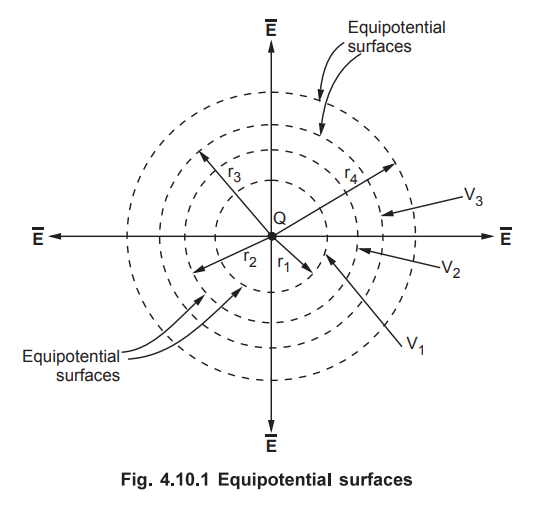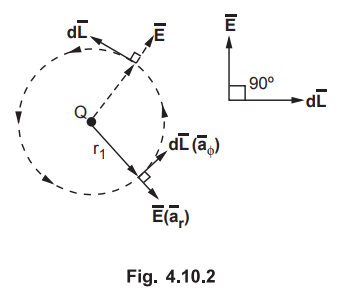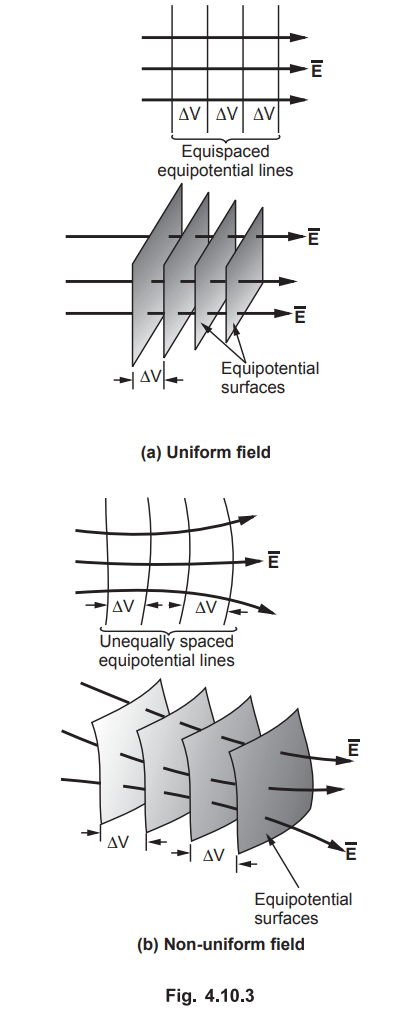Electromagnetic Theory: Unit II: (a) Electric Work Potential and Energy
Equipotential Surfaces
Electrostatics
Key Point : An equipotential surface is an imaginary surface in an electric field of a given charge distribution, in which all the points on the surface are at the same electric potential.
Equipotential Surfaces
•
In an electric field, there are many points at which the electric potential is
same. This is because, the potential is a scalar quantity which depends on the
distance between the point at which potential is to be obtained and the
location of the charge. There can be number of points which can be located at
the same distance from the charge. All such points are at the same electric
potential. If the surface is imagined, joining all such points which are at the
same potential, then such a surface is called equipotential surface.
Key
Point : An equipotential surface is an imaginary surface
in an electric field of a given charge distribution, in which all the points on
the surface are at the same electric potential.
•
The potential difference between any two points on the equipotential surface is
always zero. Thus the work done in moving a test charge from one point to
another in an equipotential surface is always zero. There can be many
equipotential surfaces existing in an electric field of a particular charge
distribution.
•
Consider a point charge located at the origin of a sphere. Then potential at a
point which is at a radial distance r from the point charge is given by,
V
= Q / 4πƐ0r
•
So at all points which are at a distance r from Q, the potential is same and
surface joining all such points is equipotential surface.
•
Similarly at r = r1 r = r2 ... there exists other equipotential
surfaces, in an electric field of point charge, in the form of concentric
spheres as shown in the Fig. 4.10.1.

•
It can be noted that V is inversely proportional to distance r. Thus V1
at equipotential surface at r = r1 is highest and it goes on
decreasing, as the distance r increases. Thus V1 > V2
> V3 > As we move away
from the charge, the ![]() decreases hence potential of equipotential surfaces goes
on decreasing. While potential of equipotential surfaces goes on increasing as
we move against the direction of electric field.
decreases hence potential of equipotential surfaces goes
on decreasing. While potential of equipotential surfaces goes on increasing as
we move against the direction of electric field.

•
For a uniform field ![]() , the equipotential surfaces are perpendicular to
, the equipotential surfaces are perpendicular to ![]() and are equispaced for fixed increment of voltages. Thus if we move a charge
along a circular path of radius г1 as shown in
and are equispaced for fixed increment of voltages. Thus if we move a charge
along a circular path of radius г1 as shown in ![]() direction, then
work done is zero. This is because
direction, then
work done is zero. This is because ![]() and
and ![]() are perpendicular. Thus
are perpendicular. Thus ![]() and equipotential
surface are at right angles to each other.
and equipotential
surface are at right angles to each other.
•
For a nonuniform field, the field lines tends to diverge in the direction of
decreasing ![]() Hence equipotential surfaces are still perpendicular to
E but are not equispaced, for fixed increment of voltages. The equipotential
surfaces for uniform and nonuniform field are shown in the Fig. 4.10.3 (a) and
(b).
Hence equipotential surfaces are still perpendicular to
E but are not equispaced, for fixed increment of voltages. The equipotential
surfaces for uniform and nonuniform field are shown in the Fig. 4.10.3 (a) and
(b).

Review Question
1. Explain the concept of equipotential surfaces.
Electromagnetic Theory: Unit II: (a) Electric Work Potential and Energy : Tag: : Electrostatics - Equipotential Surfaces
Related Topics
Related Subjects
Electromagnetic Theory
EE3301 3rd Semester EEE Dept | 2021 Regulation | 3rd Semester EEE Dept 2021 Regulation
